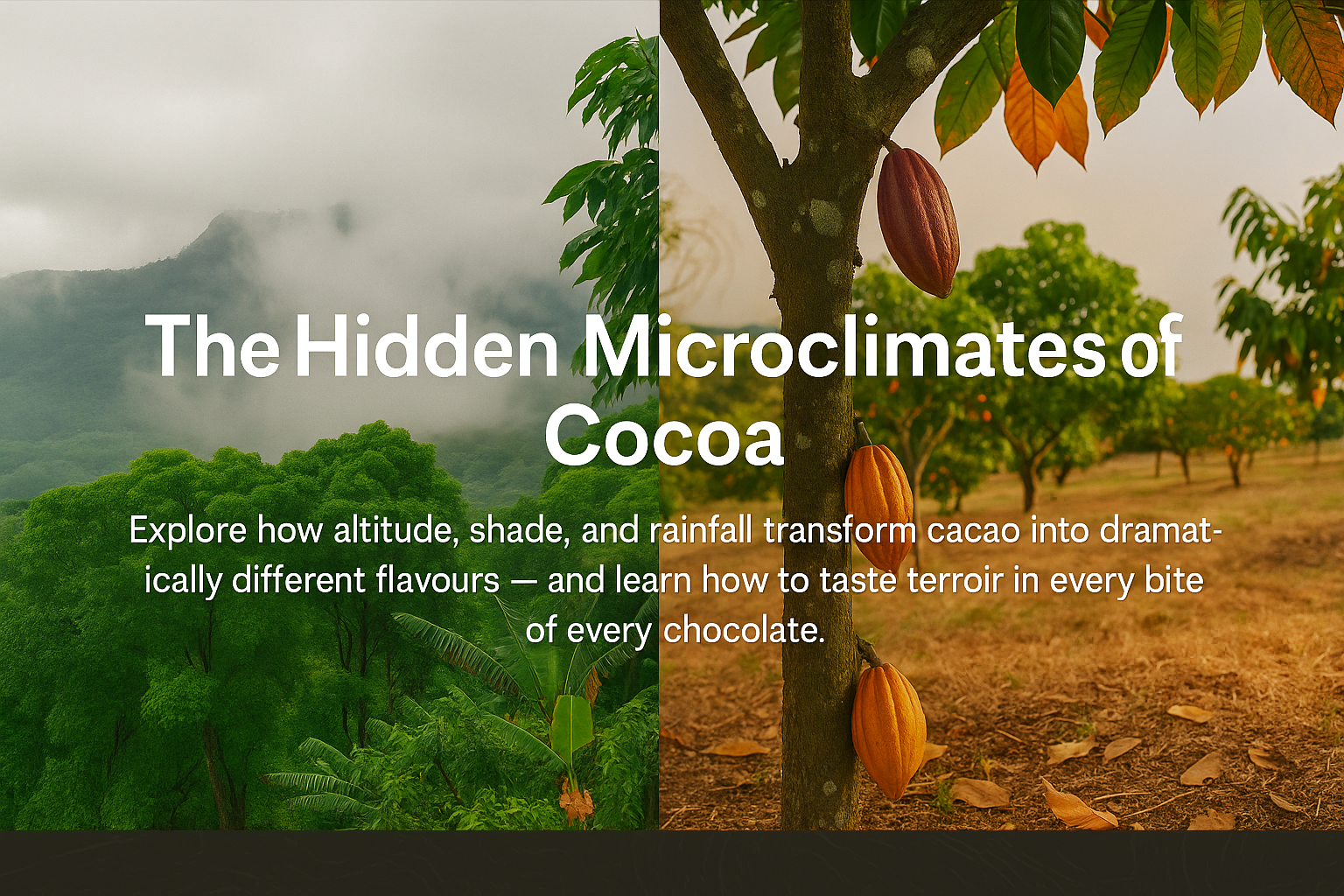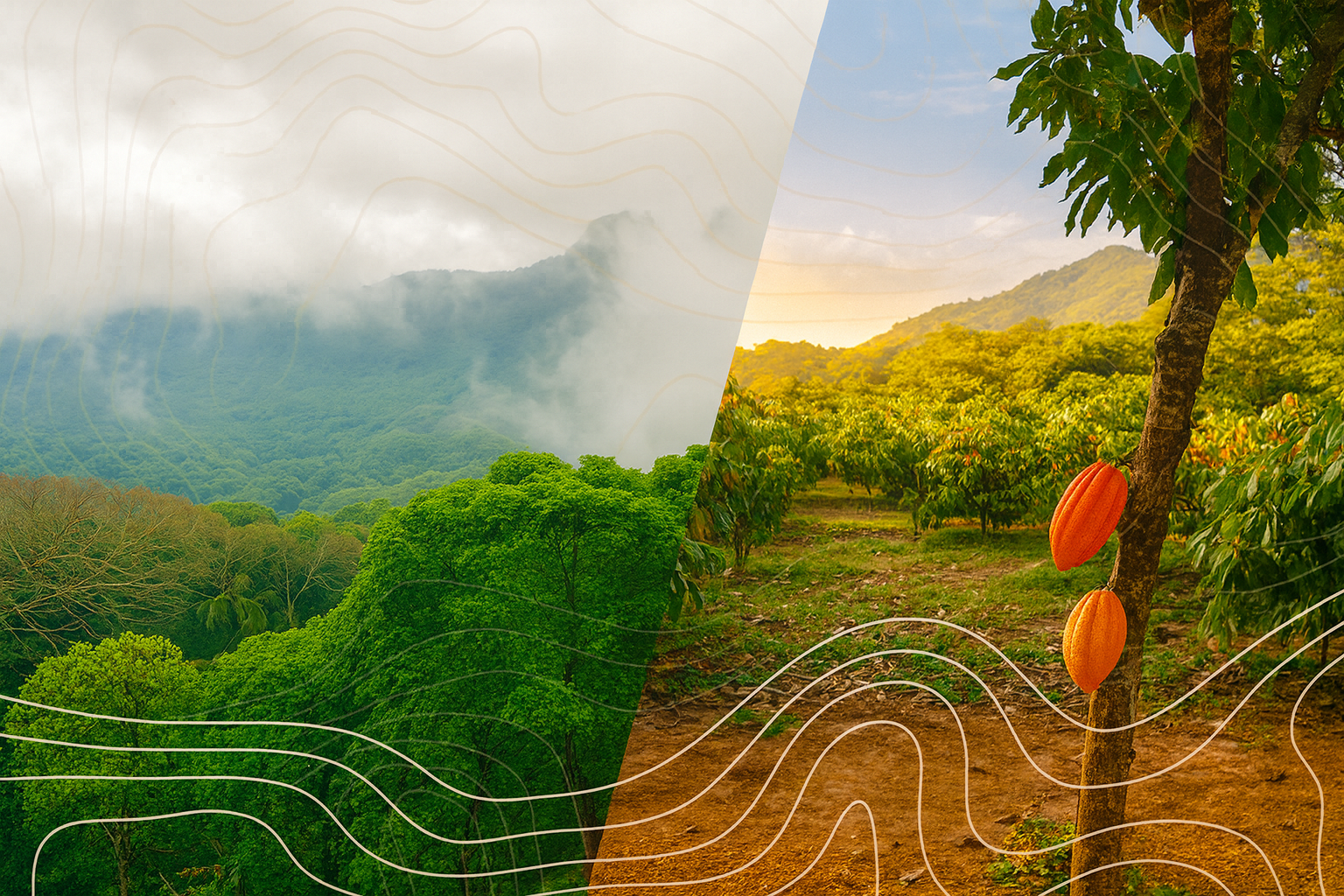Why Cocoa’s Microclimate Matters
Cacao is more than a crop it’s a storyteller every pod carries the memory of its soil, the rhythm of its rain, and the breath of its forest. Just as wine celebrates terroir, cocoa has its own subtle fingerprint of place.
Even the smallest variations in shade, altitude, soil, or rainfall can transform what ends up in your cup or chocolate bar.
I first discovered this while visiting farms in Ghana, one morning, the air in the hills was cool and citrus-bright, the pods glistening with night rain, later that same day, I visited a drier lowland farm just a short drive away. The difference was astonishing the first beans sang with orange-flower brightness, while the second offered a deep, earthy chocolate richness. Both were beautiful, but both told completely different flavour stories.
What Is a Cocoa Microclimate?
A microclimate is a small, localised climate zone that differs from the surrounding area. For cocoa, that can mean:
Altitude: Beans grown at 300 m taste different from those at 1,200 m.
Shade Cover: Agroforestry systems with plantain, mango, or hardwood trees protect cocoa, slow ripening, and boost complexity.
Rainfall & Humidity: Pulp sugar levels and fermentation speed shift with rainfall too much or too little can make or break a harvest.
Soil Type: Volcanic, sandy, or loamy soils feed different nutrients into the tree, altering bean chemistry and polyphenol balance.
Temperature Swings: Warm days and cool nights create slower-ripening pods and more refined flavours, much like high-altitude coffee.
These factors directly affect sugar content, acidity, and polyphenol structure which is why two farms just a few kilometres apart can produce dramatically different chocolate.
Microclimate Factor Likely Flavour Impact
High Altitude (800 m+) Brighter acidity, floral or citrus notes
Lowland Warm Zones Earthy, nutty, round chocolate base
Dense Shade. Softer tannins, balanced sweetness, slower fermentation
Full Sun Intense cocoa body, sometimes more bitterness
Volcanic Soil Complex minerality, fruity lift
Drier Region. Concentrated flavour, less mucilage, shorter fermentation
Case Study: Two Farms, Two Stories
On a recent Chocolate Safari® origin trip, we fermented beans from two farms just 10 km apart:
Valley Farm (Shaded): Rounder, creamy, almost caramelised profile.
Ridge Farm (Breezy): Brighter acidity, red-fruit notes, lively finish.
Same variety. Same co-op. Same harvest week only the microclimate was different.
Why Microclimates Matter
For Farmers: Preserving shade trees, soil health, and watershed areas isn’t just good for the planet it’s a flavour decision.
For Chocolate Makers: Buying from distinct microclimates allows for single-parcel, limited-edition bars with unique flavour stories.
For Judges & Educators: Recognising microclimate differences deepens sensory literacy and raises appreciation for fine-flavour cocoa.
With climate change shifting rainfall patterns and heating the traditional cocoa belt, microclimate management is becoming urgent. Shade trees, water protection, and canopy diversity can buffer farms against extremes and preserve flavour for future generations.
How to Taste Microclimate in Chocolate
Try this at home or with your team:
1. Select Origins: Buy two single-origin bars from the same country but different regions (e.g. Ghana Ashanti vs Ghana Volta).
2. Look · Touch Listen · Smell · Taste: Use my five-sense tasting method to explore colour, snap, aroma, and flavour evolution.
3. Compare Notes: Which is fruitier? Which is deeper, nuttier, or more floral?
4. Discuss Terroir: Talk about rainfall, altitude, and shade and what might explain the differences.
The Bigger Picture
Cocoa microclimates remind us that chocolate is more than a product it’s a landscape, a climate, a moment in time.
Every bite honours the farm, the farmer, and the weather that shaped that harvest.
Join the Journey
Ready to taste the difference for yourself?
Book a Chocolate Safari® or private tasting workshop and decode cocoa terroir with me.


